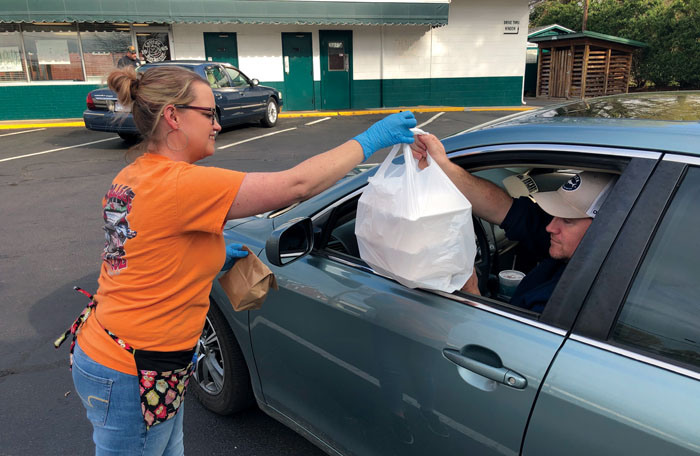County sees better-than-expected decreases in tax revenue from COVID-19 shutdowns
Published 10:20 pm Thursday, July 23, 2020

- Salisbury Post file photo — Server Tina Meyler, who works at College Barbecue, located at 117 Statesville Blvd., provides a customer with curbside service in March after state restrictions put limits on dining in.
By Natalie Anderson
natalie.anderson@salisburypost.com
SALISBURY — Tax revenue for April has pleasantly surprised some local leaders, indicating Rowan County has weathered the COVID-19 storm fairly well.
The total amount of sales tax generated in Rowan County for the month was $5.69 million, only slightly less than $5.89 million in April 2019, according to Tourism Development Authority Director James Meacham. Additionally, the total taxable goods sold was $119.3 million for April compared to $122.5 million in April 2019. That doesn’t include restaurants because they don’t charge sales tax.
These numbers indicate that the county “held pretty well,” Meacham said, especially compared to the state of the economy before the pandemic.
The less-than-expected decreases can likely be attributed to local residents receiving unemployment benefits, stimulus checks and Paycheck Protection Program loans received by businesses, which shows local citizens are “still supporting local businesses even in difficult times,” he said.
Rowan County government’s share of the sales tax revenue, according to the North Carolina Department of Revenue, is $2.33 million. County Finance Director Leslie Heidrick said the total share in April 2019 for the county was $2.31 million, which surprised her since the county was anticipating a steep decrease, not a slight increase.
She noted, however, that sales tax figures fluctuate each month.
Rowan County Manager Aaron Church said revenue from the next few months is still needed before leaders are able to more accurately gauge the financial impact.
Meacham echoed Church’s remarks and noted that the long-term impact remains to be seen, particularly as the added unemployment benefits granted by the federal government are set to expire at the end of July. It’s concerning since many people receiving those benefits work in industries that haven’t reopened yet.
Nonetheless, a series of decreases will still have a “residual impact” on the economy, he said.
The issue of adequate child care and supervision of virtual learning, especially among elementary-aged children, creates another complexity for families trying to get back into the workforce, Meacham said. Some jobs don’t allow for remote work, leaving parents to decide how to take care of their children who are learning from home.
Other factors that leaders are “really having to monitor” that can hurt both the state and local economy include the potential lack of sports and a football season, resulting in no high school homecomings, which drive revenue. Additionally, the lack of weddings hurts caterers and other vendors, and many arts and entertainment venues are still closed.
All of these factors are considered “moving parts and pieces yet to be determined,” Meacham said.
At the July 21 city council meeting, Salisbury’s finance director Shannon Moore told council members the total sales tax collections for the city from the month of April amounted to $660,268, which was 6.2% lower than April 2019 and 12.6% lower than March. She noted the amount is not as low as other cities in the state with larger hospitality sectors, but it was still about $100,000 more than the city anticipated.
The state Department of Revenue website lists the amounts of the sales tax revenue share for each municipality as well. Those amounts, based per capita, are:
- $81,941 for China Grove
- $17,053 for Cleveland
- $28,907 for East Spencer
- $15,868 for Faith
- $59,649 for Granite Quarry
- $189,806 for Kannapolis
- $60,720 for Landis
- $41,563 for Rockwell
- $62,211 for Spencer
Contact reporter Natalie Anderson at 704-797-4246.



